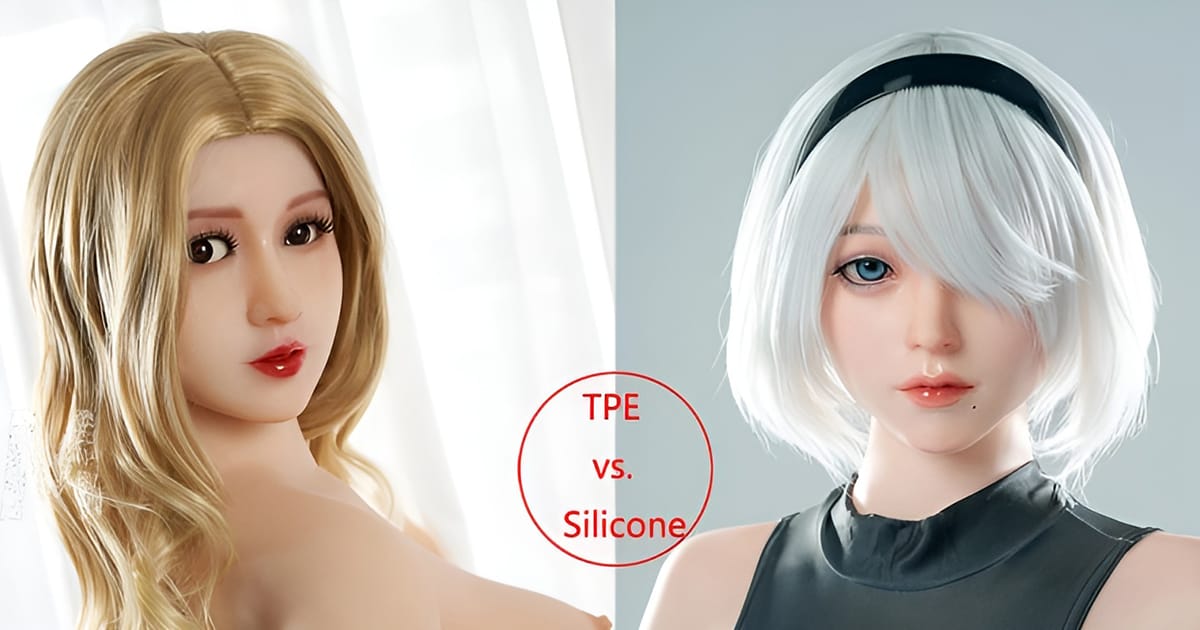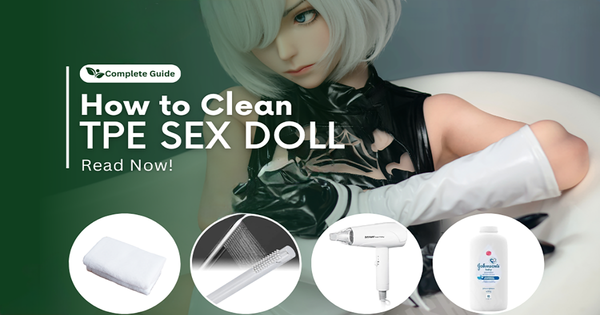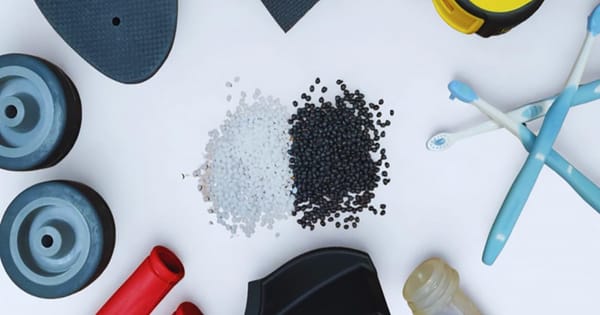TPE vs. Silicone Sex Dolls: What's the Difference?

If you’re exploring the world of sex dolls, you’ve probably noticed two materials everywhere: TPE (Thermoplastic Elastomer) and silicone. Both are designed to mimic the feel of real skin, but they each bring their own quirks when it comes to texture, durability, upkeep, and overall value. Whether you’re buying your first doll or thinking about an upgrade, knowing the differences can save you time—and frustration. Let’s dive in and see how TPE and silicone sex doll really compare across the key factors that matter most.
Material Basics: What They Are and How They Differ
Before we talk about feel and performance, it helps to understand what each material is made of—because that’s where their differences really start.
TPE
TPE is basically a mix of rubber and plastic, designed to be soft, flexible, and “squishy.” It’s thermoplastic, which means it softens with heat and hardens when it cools—a handy trait for molding detailed shapes. People love TPE for its plush, yielding texture that can feel extra lifelike. On the flip side, it’s slightly porous at a microscopic level and contains oils to keep it soft over time, which means it needs a bit more care to stay clean.
Silicone
Silicone is a synthetic polymer famous for stability and smoothness. High-quality, medical-grade silicone is non-porous and inert, so it doesn’t react with moisture, chemicals, or temperature changes. Unlike TPE, silicone is a thermoset—once it’s cured during production, it keeps its shape no matter what. Its firmer texture lets manufacturers capture sharper details, while the surface feels silky and can even warm up slightly to mimic real skin.
Tactile Experience: Which One Feels More “Real”?
For most buyers, the feel of a doll is the dealbreaker. Let’s break down how TPE and silicone compare:
TPE: Soft… Maybe Too Soft
TPE’s biggest selling point is its extreme squishiness. Press into a TPE doll’s skin, and it sinks easily, giving that “pillowy” or memory-foam vibe. If you love a super giving feel—especially in areas like the breasts or butt—it can be very satisfying.
But there’s a catch. TPE stretches and deforms more easily than silicone, so if you grip a limb too hard, it can lose shape. It also can feel a bit rubbery at first, and those natural oils that keep it soft? They can leave a slightly greasy residue on your hands.

Silicone: Soft, Realistic, and Responsive
Silicone, on the other hand, nails the balance. It’s firm enough to hold its shape, yet soft where it counts. Press down, and it yields just enough before bouncing back—much like real skin.
Temperature-wise, silicone shines. Unlike TPE, which can stay cool even after hours of contact, silicone warms up gradually, making the experience feel more intimate. Its smooth, non-greasy surface adds to the realism—a matte, soft finish that feels very close to the real thing.
If you want a touch that actually mimics human skin, silicone wins hands down.

Durability & Longevity: Which One Lasts Longer?
Buying a sex doll is an investment, so how long it lasts matters. When it comes to durability, the difference between TPE and silicone couldn’t be clearer.
TPE: Great Feel, Short Shelf Life
TPE sex dolls feel soft and squishy, but that comes with a catch: they need constant care. On average, a well-kept TPE doll lasts just 2–3 years.
Some common TPE headaches include:
- Oil leakage: The natural oils that keep it soft can stain sheets, clothes, or storage surfaces. Over time, losing these oils can make the doll dry out, crack, or even get brittle.
- Heat sensitivity: TPE doesn’t like high temperatures. Keep it out of direct sunlight, hot baths, or heating pads—or you risk warping or melting.
- Staining & tearing: Its porous surface traps makeup, dark clothing dyes, and other pigments. Pull too hard or stretch it excessively, and tears can happen.
Even with careful maintenance, TPE just doesn’t hold up as long as silicone.
Silicone: Built to Last
Silicone sex dolls are in a league of their own when it comes to longevity. With proper care, a medical-grade silicone doll can easily last 5–10 years—or more—making it a smart long-term investment.
Here’s why silicone stands up so well:
- Heat and cold? No problem: Silicone tolerates extreme temperatures without cracking, warping, or hardening.
- Chemical resistant: Soap, water-based lube, and sanitizers won’t harm it.
- No staining or tearing: Its smooth, non-porous surface repels pigments, and it’s strong enough to handle regular use without ripping.
The only minor downside? Over many years, painted details like eyebrows or lips might fade—but a quick touch-up from a pro can bring them back.
Bottom line: if you want a doll that keeps looking and feeling great for years, silicone is the clear winner.
Maintenance & Hygiene: Which One’s Easier to Care For?

When it comes to adult companions, hygiene isn’t optional—and TPE and silicone handle it very differently.
TPE: Soft, Squishy… and High-Maintenance
TPE feels great, but it demands a lot of attention. Its porous texture attracts bacteria, mold, and odors, so keeping it clean is no small task. Here’s what TPE care looks like:
- After-use cleaning: You’ll need a specialized, pH-balanced cleaner (regular soap can damage it) and a thorough rinse. Miss any moisture trapped in the pores, and mold can appear.
- Drying: TPE has to air-dry completely—never towel-dry, or lint sticks to that oily surface. Yep, it can take hours.
- Regular upkeep: Every 1–2 months, you’ll need to apply a TPE “renewal oil” to keep it from drying out.
- Odor control: Even with proper cleaning, a faint chemical smell can develop over time.
For anyone busy—or not a fan of tedious chores—TPE’s maintenance can feel like a lot of work.
Silicone: Easy, Clean, and Low-Stress
Silicone, on the other hand, makes life way simpler. Its non-porous surface is naturally hygienic, so cleaning is quick and stress-free:
- After-use cleaning: Just rinse with warm water and mild soap (or a toy cleaner) and wipe dry with a lint-free towel. That’s it. Bacteria can’t get inside, so a fast rinse keeps it safe.
- Drying: Silicone dries in minutes, and lint won’t stick to it.
- Long-term care: No oils, no conditioners—just store it in a cool, dry place to avoid dust.
- Odor resistance: New silicone is odorless, and it stays that way—no funky smells, no trapped odors.
Bottom line: if you want a companion that’s easy to care for without sacrificing hygiene, silicone is the clear winner.
Aesthetic Detail: Which One Looks More Lifelike?
Realism isn’t just about how a doll feels—it’s also about how it looks. From facial features to body curves, the details make all the difference.
TPE: Soft but a Bit Blurry
TPE is flexible, which makes it easy to shape into basic body forms, but it struggles with fine details. Faces can look slightly “smudged” or soft around the edges, and painted touches like blush or eyeliner fade faster on its porous surface. Even the matte finish can make skin appear flat instead of glowing.
Body curves, like D-cup breasts, may sag more than intended, and over time, the softness can make shapes lose their definition. If you’re after the “wow” factor in looks, TPE can feel a little underwhelming.
Silicone: Crisp, Sharp, and Defined
Silicone’s firm yet flexible structure lets manufacturers capture stunningly lifelike details. Facial features pop with tiny pores, subtle lip texture, and realistic eyebrow hair. Paint adheres beautifully, so colors stay vibrant for years.
The body holds its shape beautifully, too. Breasts keep their lift, limb contours stay sculpted, and skin has a subtle sheen that mimics the glow of real skin. Some high-end silicone dolls even include vein patterns or freckles—details that TPE simply can’t replicate.
For anyone who wants a doll that looks as real as it feels, silicone takes the crown—hands down.
Price: TPE Is Cheaper—but Is It Really Worth It?
Budget matters, and there’s no denying TPE dolls have a clear upfront advantage.
TPE Dolls: Entry-level models usually start around $800–$1,500, with mid-range options topping out near $2,500. The lower price comes from cheaper materials and faster manufacturing.
Silicone Dolls: Entry-level silicone dolls start around $1,500–$2,000, while high-end medical-grade models can run $3,000–$6,000—or even more for fully customized designs.
But here’s the catch: price isn’t just about the sticker tag. Longevity changes the game. A $1,200 TPE doll that lasts about 2 years costs roughly $600 per year. A $3,000 silicone doll that lasts 6 years? That’s just $500 per year—and that’s before you factor in TPE maintenance costs like special cleaners, renewal oil, or replacement parts for tears and stains.
When you look at it this way, silicone isn’t just more durable—it’s actually a smarter investment over time.
Which Should You Choose? A Quick Guide
Still not sure which material is right for you? Here’s a simple way to match your needs:
Go for TPE if:
- You’re on a tighter budget and want to try out a doll before committing to a premium model.
- You love that ultra-soft, “squishy” feel more than long-term durability.
- You don’t mind spending time on maintenance and expect to replace the doll every 2–3 years.
Go for Silicone if:
- You want a realistic, long-lasting companion that can last 5+ years.
- Low maintenance and hygiene are top priorities—you don’t want extra upkeep stress.
- You care about lifelike details—think sharp facial features, sculpted curves, and realistic skin texture.
- You’re willing to invest more upfront for better value and durability over time.
In short: TPE is great for trying things out or if you love softness. Silicone is the way to go for realism, longevity, and low-maintenance enjoyment.
Final Thoughts
TPE dolls definitely have their place—especially if you’re watching your budget or just want to try one out. But when it comes to the full experience—realism, durability, hygiene, and long-term value—silicone clearly takes the lead. Sure, TPE is soft and squishy, but that perk fades quickly. Silicone, on the other hand, feels lifelike, holds up over time, and keeps maintenance simple—making it the go-to choice for anyone serious about a lasting, realistic companion.
At the end of the day, it all comes down to your priorities. If you want a doll that looks, feels, and lasts like the real deal, silicone isn’t just the better option—it’s the one that truly delivers.



